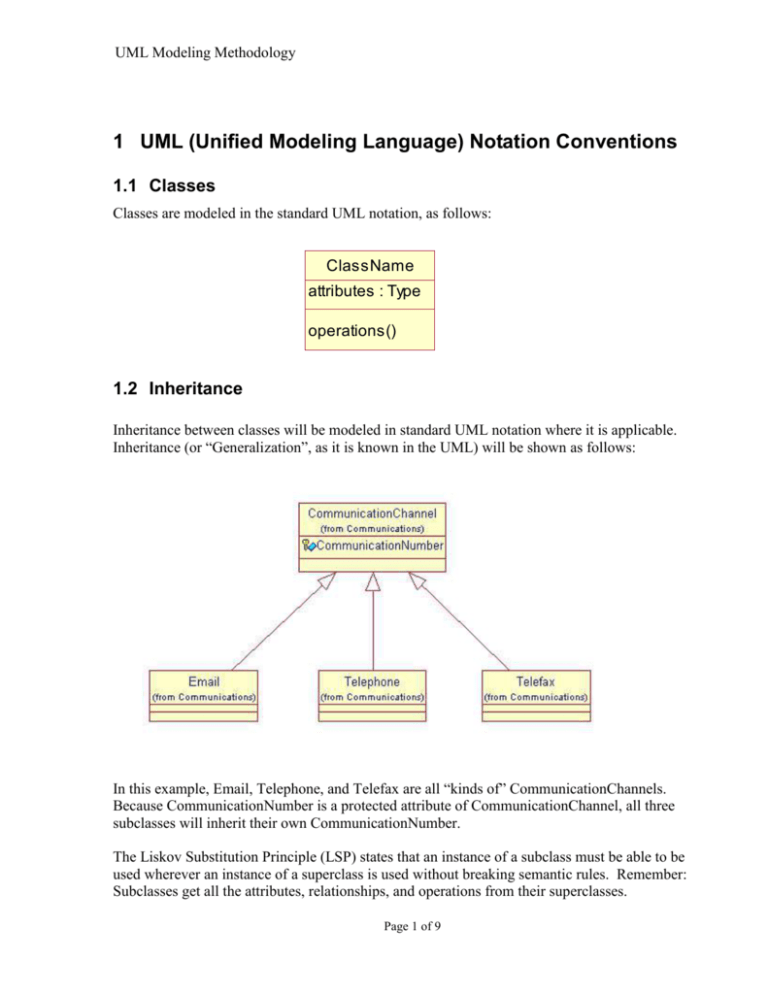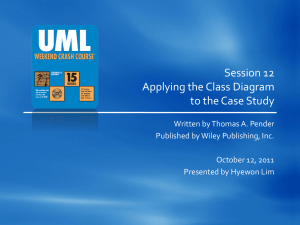1 UML Notation Conventions
advertisement

UML Modeling Methodology 1 UML (Unified Modeling Language) Notation Conventions 1.1 Classes Classes are modeled in the standard UML notation, as follows: ClassName attributes : Type operations() 1.2 Inheritance Inheritance between classes will be modeled in standard UML notation where it is applicable. Inheritance (or “Generalization”, as it is known in the UML) will be shown as follows: In this example, Email, Telephone, and Telefax are all “kinds of” CommunicationChannels. Because CommunicationNumber is a protected attribute of CommunicationChannel, all three subclasses will inherit their own CommunicationNumber. The Liskov Substitution Principle (LSP) states that an instance of a subclass must be able to be used wherever an instance of a superclass is used without breaking semantic rules. Remember: Subclasses get all the attributes, relationships, and operations from their superclasses. Page 1 of 9 UML Modeling Methodology 1.3 Relationships 1.3.1 Associations Associations will be represented in standard UML notation, with role names and multiplicities specified as follows: Quantity value : int +requestedQuantity 1 OrderLineItem lineItemNumber : int 1 In this case, the association is unidirectional. OrderLineItem can “see” or initiate communication with Quantity, but not the other way around. 1.3.2 Aggregation Aggregation will be represented in standard UML notation, with role names and multiplicities Party 1 NameAndAddress name : String <<optional>> street : String city : String +theNameAndAddress <<optional>> state : String 1 <<optional>> postalCode : String countryISOCode : String languageOfTheParty : String specified as follows: In this case, the aggregation indicates NameAndAddress is “a part of” the Party. Page 2 of 9 UML Modeling Methodology 1.3.3 Dependencies A dotted arrow will illustrate dependencies: TradeItemMeasures netContent : Measurement grossWeight : Measurement packingWeight : Measurement <<optional>> degreeOfOriginalWort : String <<optional>> depth : Measurement <<optional>> diameter : Measurement <<optional>> drainedWeight : Measurement <<optional>> fatContent : Measurement <<optional>> fatContentBasisOfMeasurement : Measurement <<optional>> height : Measurement <<optional>> numberOfCompleteLayersPerTradeItem : int <<optional>> numberOfLayersPerPallet : int <<optional>> numberOfTradeItemsContainedInACompleteLayer : int <<optional>> numberOfTradeItemsPerPallet : int <<optional>> numberOfTradeItemsPerPalletLayer : int <<optional>> pegHorizontal : Measurement <<optional>> pegVertical : Measurement <<optional>> percentageOfAlcoholByVolume : float <<optional>> width : Measurement Measurement unitOfMeasure : String value : float The above diagram shows that TradeItemMeasures depends on Measurement. Many of the attributes in TradeItemMeasures rely directly on Measurement to describe their type. 1.4 Multiplicity Multiplicity is shown in the standard UML notation. Without one of the following multiplicities, a relationship is not considered completely defined. Notation 1 1..n 0..n 0..1 n Meaning Exactly one (mandatory) One or more (mandatory) Zero or more (optional) Zero or one (optional) Exact amount greater than one (mandatory) * not currently supported Page 3 of 9 UML Modeling Methodology 1.5 Attributes Each attribute will have a “EAN.UCC tab” that will describe: 0 1 2 3 Min – Minimum value for the attribute. Max – Maximum value for the attribute. Mask – The format of the attribute (i.e. The mask for a SSN would be: 999 – 99 – 9999) Values List – Possible values for the attribute if the attribute is an enumerated type (i.e. The Value for marriageStatus would be Single, Married, Divorced, or Widowed). NOTE: If the attribute has a fixed value, the Minimum and Maximum values should be set to the same number. For example, for the attribute freezingPointOfWater, the Minimum and Maximum would both be set to 0. The “Mask” field of the EAN.UCC tab will be used to describe the formatting of an attribute. For example, if the first 3 characters of a serial number are letters and the last 5 are digits, the EAN.UCC tab would be filled out as follows: Page 4 of 9 UML Modeling Methodology 1.6 Naming Conventions Consistent naming conventions will be used throughout the model. The basic rules shall be as follows: 0 1 2 3 Class names will be displayed as InitCaps. Class names will also be singular. Names of Collections will be plural. Attribute names/Association role names will be displayed as InitCaps except for the first letter, which will be lowercase. For example: Contact personOrDepartmentName : TextDescription <<enumeration value>> contactType : String +theCommunicationChannels 1 0..n Page 5 of 9 CommunicationChannel <<enumeration value>> channelType : String communicationChannel : String UML Modeling Methodology 1.7 Notes Notes are used to elaborate when the UML notation does not describe sufficiently. Notes are an unstructured means of expression and should be replaced with structured notation wherever possible. In this example, the requirement to have at least one LogisticUnit or one ItemContainment is captured in a note. 1.8 Role Names OrderPartyIdentification <<enumeration value>> role : String +seller 1 1 +buyer 1 +shipTo 1 1 Order 1 1.9 Role names note the purpose or capacity of a class in association with another class. The role name is placed near the class it modifies. Role names are used to clarify the relationship between two classes, and should be used as a matter of course.Types Page 6 of 9 UML Modeling Methodology Data types shall be used for all attributes. These types describe the format used when the attribute is realized. Types shall conform to standard UML types or special types defined for the EAN.UCC System. 1.9.1 Standard UML Types Boolean: an enumerated type with the two values True or False. Float: a number represented by a mantissa and an exponent according to a given base (the sum of an integer and decimal). Integer: a positive and negative whole number. Single: a single character. String: a sequence of characters. 1.9.2 Special Types Date: The class Date. Measurement: The class Measurement. TextDescription: Text up to n characters in length. Quantity: The class Quantity. GlobalTradeItemNumber: Complying with the GTIN data format (class). GlobalLocationNumber: Complying with the GLN data format (class). SSCC: Complying with the SSCC data format (class). 1.10 Stereotypes A shorthand syntax for extensions to the metamodel, stereotypes indicate the use a specific extension. Stereotype names are always shown between guillamets (<< >>). <<enumerationvalue>>Applies to a class. The class is a constrained list of values from which one value is used to realize an attribute. <<extends>> Applies to the relationship between two use-case realizations. An extend relationship means that a use-case realization extends the behavior described in another usecase realization. <<includes>> Applies to the relationship between two use-case realizations. An include relationship means that a use-case realization includes the behavior described in another usecase realization. Page 7 of 9 UML Modeling Methodology <<optional>> Applies to an attribute. Indicates the attribute is optional within the class. Equates to a cardinality if 0..1 at the attribute level. <<realize>> Applies to relationship between use-case realization and use-case. The dependency between the use-case realization and the realized use-case is qualified with the «realize» stereotype. <<UCR>> Applies to a UsecaseRealization package, which describes how each use-case, defined in the Requirements Analysis activity, translates into the solution. 1.11 Enumerated Values This convention is for an attribute instantiated from a constrained set of values. The approach will accommodate any kind of list, including natural language lists. Literally enumerated values or code lists are not necessary, but can also be accommodated. A class containing a constrained set of values shall be identified with the stereotype <<enumeration value>>. Only one of these values, shown as attributes, would be used to Contact personOrDepartmentName : TextDescription 1 +theCommunicationChannel CommunicationChannel s communicationChannel : String 0..n 1 1 1 1 <<enumeration value>> ContactType accountingContact purchasingContact salesAdministration <<enumeration value>> ChannelType email telephone telefax website instantiate the class. For example: The values are provided as attributes. No additional typing is needed, as the attributes shown are the values. 1.12 Root – (UML assign: XML impact) The root element in a diagram will be shown in Red. In this diagram, Order is the Root Element. Page 8 of 9 UML Modeling Methodology Page 9 of 9




